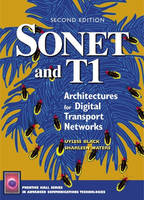
Sonet and T1
Prentice Hall (Verlag)
978-0-13-065416-8 (ISBN)
- Titel ist leider vergriffen;
keine Neuauflage - Artikel merken
PLEASE PROVIDE
SONET is the flexible, highly interoperable transport technology at the heart of today's high-speed optical networks. SONET: Architecture for Digital Transport Networks, Second Edition covers every facet of SONET technology, including the new IP-over-SONET "optical Internet," SONET's relationship to WDM, and other key innovations. The authors begin with an overview of SONET's goals and architecture; then present the most detailed coverage of SONET operations, administration, and management available in any book. They reflect important changes to SONET technology and standards, including changes to network management, and new applications. This edition shows SONET at work in both MANs and long-haul networks. It also includes a new chapter on SDH, the European SONET standard, and interworking between SONET and SDH networks.
UYLESS BLACK is a widely respected telecommunications consultant and lecturer with extensive operations and implementation experience in both public and private networks. His clients include Nortel, British Telecom, and major carriers throughout the U.S. His recent books include Voice Over IP, Second Edition; IP Routing Protocols; and MPLS and Label Switching Networks. SHARLEEN WATERS has served for fifteen years as GTE Senior Technical Instructor in Broadband Technologies, training clients such as AT&T, Nortel, Siemens, Alcatel, NEC, and Fujitsu in installing, testing, and maintaining SONET equipment.
Preface.
Acknowledgments.
Notes for the Reader.
1. Introduction.
What Are SONET and T1? The Development of SONET. Precursors to SONET. Participation by ITU-T. Key ITU-T Documents. Role of ANSI and Key Standards. Documents. The Network and Services Integration Forum (NSIF)). SONET and T1. Comparison of SONET and T1. Features of SONET and T1. Synchronous Networks. The Perils of Bit Stuffing. SONET Timing. The Benefits of Byte Alignment. Floating Payloads. Payloads and Envelopes. Optical Fiber-the Bedrock for SONET. Typical SONET Topology. Present Transport Systems and SONET. Clarification of Terms. Summary.
2. Digital Transmission Carrier Systems.
Organization of Telephone Services. Types of Signaling. Control Signaling. E&M Signaling. Other Signaling. Connecting the User to the Telephone System. Two-Wire Interface at Both Ends. Four-Wire Interface at Both Ends. Four-Wire Interface at One Site and Two-Wire at the Other Site. Intraexchange or Intracity Private Lines. Typical Applications. Frequency Division Multiplexing (FDM Carrier Systems. Analog-to-Digital Conversion. Classification of Speech Coders. Time Division Multiplexing (TDM). Pulse Modulation. PAM. PCM. Sampling, Quantizing, and Encoding. Segment Approximation. PCM Algorithms: µ-Law and A-Law. Other Analog-to-Digital Techniques. Differential PCM (DPCM) and Adaptive DPCM (ADPCM). Sub-Band ADPCM (SB-ADPCM). Delta Modulation (DM) and Continuously Variable Slope Delta Modulation (CVSD). Voice Compression Techniques: Code Excited Linear Prediction. Newer Digital Voice Schemes. Convolutional Coding. The Repetition Function. Voice Quality Categories: A General View. The New Voice Coders. Conserving Bandwidth with Voice Activity Detection (VAD). Summary. Appendix 2A: Coding and Coding Violations.
3. Timing and Synchronization in Digital Networks.
Timing and Synchronization in Digital Networks. Effect of Timing Errors. The Clocking Signal. Timing (or Synchronization) Distribution. Clocking Rules. Types of Timing in Networks. Plesiochronous and Asynchronous Networks. Synchronous Networks. The Synchronous Clock Hierarchy. Summary and Clarification of Terms. Timing Variations. Frequency Accuracy. Dealing with the Timing Problems. Slip Operations in More Detail. Slips-Controlled and Uncontrolled. Bit or Clock Slips. Frequency Departures and Accuracies. Methods of Clock Exchange. Free-Running. Line-Timed. Loop-Timed. External. Through-Timed. Distribution of Timing Information with SONET and DS1 Signals. Decoupling the Clocks. Other Uses and Examples of Pointer Operations. Floating Payloads and the SONET Pointer. Locked Mode. Bit Stuffing for Uniformity. Timing Downstream Devices. Source Clock Frequency Recovery for Asynchronous Transfer Mode (ATM) Systems. Synchronization Status Messages and Timing Loops. Examples of Timing Supply Systems. Use of Timing Supply Systems. The Global Positioning System (GPS). The Building Integrated Timing Supply. The Network Time Protocol (NTP). Summary.
4. The T1 Family.
T1 Line Configurations. The Digital Network. DS1 Frame Format. Advantages of the Bipolar Code. Introduction to The D Family Channel Banks. North American Asynchronous Digital Hierarchy. Digital Loop Carrier Systems. T1 Line and Trunks. D1 Channel Banks. Basic Operations. Demise of the D1 Channel Bank. D1D Channel Banks. D2 Channel Banks. Robbed Bit Signaling. The Superframe. Alarm Methods. D3 Channel Banks. D4 Channel Banks. Operating Modes. Vendors' D4 Channel Banks. AT&T's D4. Nortel Networks' DE4 and DE4E. Other D4 Features. B8ZS. Clear Channel Capability. Zero-Byte Time Slot Interchange (ZBTSI). Extended Superframe Format. D5 Channel Banks. Summary of the Use of the Eighth Bit. Subscriber-type Systems. GR-303. Final Thoughts on the D Channel Banks. Fractional T1 (FT1). Dividing and Filling the T1 Channel. Compensating for Clock Differences in a T1 System. Summary. Appendix 4A: Frame Formats. Frame Formats.
5. SONET Operations.
Example of SONET Interfaces. SONET Configuration. OAM at the Three Components. Configuration Possibilities. Automatic Protection Switching (APS). Achieving Structural Diversity. SONET Layers. SONET Signaling Hierarchy. Beyond OC-192. SONET Envelopes. Examples of Payload Mappings. The SONET Envelope in More Detail. Payload Pointers. The Control Headers and Fields. SONET Equipment and Topologies. Summary.
6. Payload Mapping and Management.
A Brief Review. SONET STS-1 Envelope. The SONET STS-3c Frame Structure. The STS-1c Envelope. AT&T DDM-2000 OC-3 Shelf. Control Circuit Pack. User Panel. Shelf Layout. Signal Flow. Mapping and Multiplexing Operations. Another View of the Multiplexing and Mapping Hierarchy. VT 1.5. VT2. VT3. VT6. The VT 1.5 Group Envelope. Summary of the VT Types. Rows and columns of the VTs. Construction of the Entire SPE. STS-1, SPE for all VT 1.5. STS-1 SPE, for all VT 2. STS-1 SPE, for all VT 3. STS-1 SPE, for all VT 6. Composite Mapping. A Final Look At Another Mapping Operation. Summary.
7. Topologies and Configurations.
Typical Topologies. Protection Switching in More Detail. The BLSR. A Common Approach. Add-Drop and Cross-Connects on Ring or Point-to-Point Topologies. One-Way Cross-Connections. One-Way DRI Cross-Connections. Two-Way Cross-Connections. Provisioning SONET Machines for Add-Drop and Cross-Connect Operations. One-Way and Two-Way Cross-Connections. One-Way Cross-Connections. Rolling Cross-Connections. Deleting Cross-Connections. Example of Protection Switching on a Two Fiber Bidirectional Ring. Cascading the Timing on Multiple Rings. Summary.
8. Operations, Administration, and Maintenance.
Need for Rigorous Testing. Alarm Surveillance. Categories of Tests. Transport Capability Tests. Payload Pointer Testing. Embedded Overhead Tests. Line Interface Tests. OAM and the SONET Layers. The SONET OAM Headers. Section Overhead. Line Overhead. Path Overhead. More Information on the D Bytes. STS-3c Frames and Overhead. Maintenance Signals and Layers. OAM Actions. Examples of OAM Operations. Troubleshooting Timing Problems. ATM and SONET OAM Operations. SONET and Network Management Protocols. The Network Management Model. Network Management Layers. Summary.
9. Manufacturers' and Vendors' Systems.
Introduction. SONET Releases. The Major Vendors. Examples of Nortel Networks' Products. Example of OPTera Node. Examples of Fujitsu's Products. New Flash Product. Other Products. Examples of Alcatel's Products. Summary of Optinex Equipment. Examples of Lucent Technologies' Products. Ring Management. Evolution of WaveStar BWM. Examples of NEC's Products.
10. The Synchronous Digital Hierarchy.
SDH Systems Connecting to the United States. Comparison Of SONET and SDH. Differences Between SONET and SDH. Key Terms. Transporting E4, H4, and DS-1 Signals. The SDH Mulitplexing Hierarchy. SONET (1.544 Mbit/s) Mapping and Multiplexing Structure. SDH (2.048 Mbit/s) Mapping and Multiplexing Structure. SONET (DS1C) Mapping And Multiplexing Structure. SONET (DS-2) Mapping And Multiplexing Structure. SONET 44.736 Mbit/s, SDH 34.368 Mbit/s, and 139.264 Mbit/s Mapping and Multiplexing Structure. Three Types of Mapping for the VC-11, VC-12, or VC-2 Signals. Asynchronous Mapping. Bit Synchronous Mapping. Byte Synchronous Mapping. Revised SDH Digital Hierarchy. SDH Overhead Bytes. The Overhead Bytes and the SDH Link Components. Comparison of the Overhead Bytes.
11. SONET and WDM, Optical Ethernet, ATM, IP, and MPLS.
Introduction. Introduction to WDM. Capacity of WDM. Running SONET over WDM. TDM SONET and WDM. Erbium-Doped Fiber (EDF). WDM Amplifers. Wavelength WDMs. Optical Cross-Connects (OXC) with WDM. Passive Optical Networks (PONs). The “Sweet Spot”. Optical Ethernets and Ethernet PONs. ATM and SONET 296 IP and SONET. ATM in the SONET Envelope. IP and PPP in the SONET Envelope. IP Over ATM. ATM vs. IP over SONET. The “Cell Tax”. Is the ATM Overhead Tolerable? Evolution of the Optical Broadband Network. Migration to Label Switching Networks. Mapping Labels to Wave Lengths. Label Switched Paths (OSPS) and Optical Switched Paths (LSPS). Protocol Stack Possibilites. Summary and Conclusions. Work Underway. A New Optical Network Model. In Conclusion.
APPENDIX A. Transmission Media.
Properties of Light and Optical Fiber. Electromagnetic Spectrum. Properties of Light: Reflection and Refraction. Total Internal Reflection. Numerical Aperture. Types of Fibers. Multimode Step-Index Fibers. Multimode Graded-Index Fiber. Single-mode Step-Index Fibers. Sources and Receivers of Optical Fiber Signals. Light-Emitting Diodes (LEDs). Lasers (Light Amplification by Stimulated Emission of Radiation). Detectors. Optical Equipment Units-Transmitter. Receiver. Transceivers. Repeaters. Fiber Cable Structure. Protecting the Fiber. Jackets. Fiber Cable Structure. Strength Member. Number of Fibers in a Cable. Fiber Losses. Spectral Attenuation. Absorption and Scattering. Radiation-Hardened Fiber. Modal Dispersion. Spectral Dispersion.
List of Terms.
References.
Acronyms.
Index.
| Erscheint lt. Verlag | 8.1.2002 |
|---|---|
| Verlagsort | Upper Saddle River |
| Sprache | englisch |
| Gewicht | 917 g |
| Themenwelt | Technik ► Nachrichtentechnik |
| ISBN-10 | 0-13-065416-7 / 0130654167 |
| ISBN-13 | 978-0-13-065416-8 / 9780130654168 |
| Zustand | Neuware |
| Haben Sie eine Frage zum Produkt? |
aus dem Bereich


